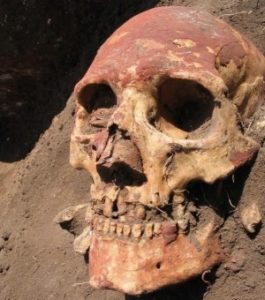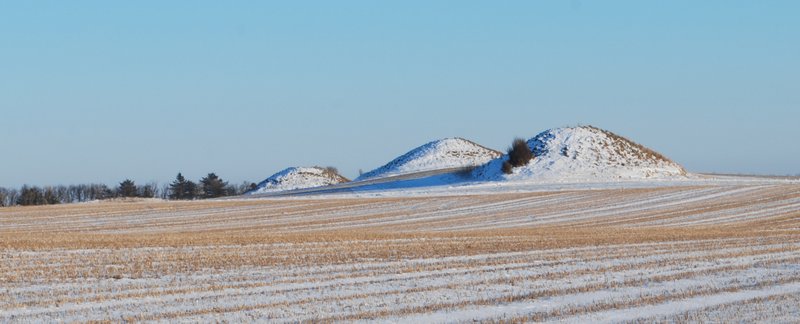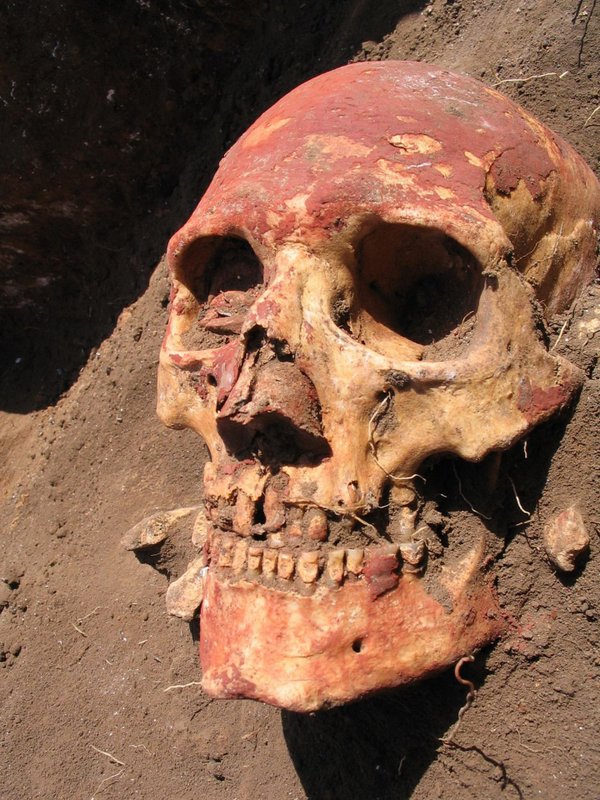
Faculty of Science, University of Copenhagen—Was it a massive migration? Or was it rather a slow and persistent seeping of people, items and ideas that laid the foundation for the demographic map of Europe and Central Asia that we see today? The Bronze Age (about 5,000 – 3,000 years ago) was a period with large cultural upheavals. But how these upheavals came about has remained shrouded in mystery.
Now, a recent study published in the journal Nature has shed new light on the question.
Says study author Morten Allentoft, Assistant Professor from the Centre for GeoGenetics at the Natural History Museum of Denmark, University of Copenhagen, “both archaeologists and linguists have had theories about how cultures and languages have spread in our part of the world. We geneticists have now collaborated with them to publish an explanation based on a record amount of DNA-analyses of skeletons from the Bronze Age.”
By analyzing the genome sequence data from samples taken from the ancient skeletal remains of 101 individuals across a broad geographic area, the researchers were able to determine a genetic “map” of past human movements that ultimately contributed to the genetic makeup of people across Eurasia today.
Geneticist and director of the Centre for GeoGenetics Eske Willerslev elaborates: “Our study is the first real large-scale population genomic study ever undertaken on ancient individuals. We analysed genome sequence data from 101 past individuals. This is more than a doubling of the number of genomic sequenced individuals of pre-historic man generated to date. The study is without any comparison to anything previously made. The results show that the genetic composition and distribution of peoples in Europe and Asia today is a surprisingly late phenomenon – only a few thousand years old.”
Professor Kristian Kristiansen of the University of Gothenburg, who initiated the project together with Lundbeck Foundation Professor Eske Willerslev, says: “The driving force in our study was to understand the big economical and social changes that happened at the beginning of the third millennium BC, spanning the Urals to Scandinavia. The old Neolithic farming cultures were replaced by a completely new perception of family, property and personhood. I and other archaeologists share the opinion that these changes came about as a result of massive migrations.”
With this new investigation, the researchers confirm that the changes came about as a result of migrations. The researchers note that it is significant because later developments in the Bronze Age are a continuation of this new social perception. It adds up, because the migrations can also explain the origin of the northern European language families. Kristiansen suggests that crucial events happened during these few centuries, as crucial as the colonization of the Americas.
A major finding of the study relates to how these migrations resulted in huge changes to the European gene-pool, conferring a large degree of admixture on the present populations. Genetically speaking, ancient Europeans from the time after these migrations are much more similar to modern Europeans than those prior the Bronze Age.
Mobile warrior people
According to the study, the re-writing of the genetic map began in the early Bronze Age, about 5,000 years ago. From the steppes in the Caucasus, the Yamnaya Culture migrated principally westward into North- and Central Europe, and to a lesser degree, into western Siberia. Yamnaya was characterized by a new system of family and property. In northern Europe the Yamnaya mixed with the Stone Age people who inhabited this region and along the way established the Corded Ware Culture, which genetically speaking resembles present day Europeans living north of the Alps today.
Later, about 4,000 years ago, the Sintashta Culture evolved in the Caucasus. This culture’s sophisticated new weapons and chariots were rapidly expanding across Europe. Areas east of the Urals and far into Central Asia were colonized around 3,800 years ago by the Andronovo Culture. The researchers’ investigation shows that this culture had a European DNA-background.
During the last part of the Bronze Age, and at the beginning of the Iron Age, East Asian peoples arrived in Central Asia. Here it is not genetic admixture we see, but rather a replacement of genes. The European genes in the area disappear.
____________________________________
 Above: A typical group of Danish Bronze Age barrows from ca. 3,500-3,100 BP. Normally they were 3-5 meters high, constructed with cut out grass turfs (sods). One barrow would demand 3 hectares of grazing land. In Denmark 50,000 such barrows were constructed during the period 3,500- 3,100 BP for the leading chiefly lineages. Courtesy Kristian Kristiansen
Above: A typical group of Danish Bronze Age barrows from ca. 3,500-3,100 BP. Normally they were 3-5 meters high, constructed with cut out grass turfs (sods). One barrow would demand 3 hectares of grazing land. In Denmark 50,000 such barrows were constructed during the period 3,500- 3,100 BP for the leading chiefly lineages. Courtesy Kristian Kristiansen
__________________________________________________
 This image shows a Yamnaya skull from the Samara region colored with red ochre. Courtesy Natalia Shishlina
This image shows a Yamnaya skull from the Samara region colored with red ochre. Courtesy Natalia Shishlina
________________________________________________
 This is a reconstruction of the Yamnaya skull. A typical Yamnaya individual from the Caspian steppe in Russia ca. 5,000-4,800 BP. Yamnaya people were tall and were buried in deep pits covered by a small barrow. Ten thousands were built during this period in the Pontic-Caspian steppe, but also in temperate Europe thousands were built as a result of the migrations. Reconstruction: Alexey Nechvaloda
This is a reconstruction of the Yamnaya skull. A typical Yamnaya individual from the Caspian steppe in Russia ca. 5,000-4,800 BP. Yamnaya people were tall and were buried in deep pits covered by a small barrow. Ten thousands were built during this period in the Pontic-Caspian steppe, but also in temperate Europe thousands were built as a result of the migrations. Reconstruction: Alexey Nechvaloda
______________________________________________
A new scale
These new results derive from DNA-analyses of skeletons excavated across large areas of Europe and Central Asia, thus enabling these crucial glimpses into the dynamics of the Bronze Age. In addition to the population movement insights, the data also held other surprises. For example, contrary to the research team’s expectations, the data revealed that lactose tolerance rose to high frequency in Europeans, in comparison to prior belief that it evolved earlier in time (5,000 – 7,000 years ago). Co-author and Associate Professor Martin Sikora from the Centre for GeoGenetics says: “Previously the common belief was that lactose tolerance developed in the Balkans or in the Middle East in connection with the introduction of farming during the Stone Age. But now we can see that even late in the Bronze Age the mutation that gives rise to the tolerance is rare in Europe. We think that it may have been introduced into Europe with the Yamnaya herders from the Caucasus, but the selection that has made most Europeans lactose tolerant happened at a much later time.
________________________________________________
Edited and adapted from a press release of the Faculty of Science, University of Copenhagen.
________________________________________________
 Read more in-depth articles about archaeology with a premium subscription to Popular Archaeology Magazine.
Read more in-depth articles about archaeology with a premium subscription to Popular Archaeology Magazine.
In addition, the latest Popular Archaeology ebook is now available.
______________________________________________
Travel and learn with Far Horizons.
____________________________________________
 Popular Archaeology’s annual Discovery Edition eBook is a selection of the best stories published in Popular Archaeology Magazine in past issues, with an emphasis on some of the most significant, groundbreaking, or fascinating discoveries in the fields of archaeology and paleoanthropology and related fields. At least some of the articles have been updated or revised specifically for the Discovery edition. We can confidently say that there is no other single issue of an archaeology-related magazine, paper print or online, that contains as much major feature article content as this one. The latest issue, volume 2, has just been released. Go to the Discovery edition page for more information.
Popular Archaeology’s annual Discovery Edition eBook is a selection of the best stories published in Popular Archaeology Magazine in past issues, with an emphasis on some of the most significant, groundbreaking, or fascinating discoveries in the fields of archaeology and paleoanthropology and related fields. At least some of the articles have been updated or revised specifically for the Discovery edition. We can confidently say that there is no other single issue of an archaeology-related magazine, paper print or online, that contains as much major feature article content as this one. The latest issue, volume 2, has just been released. Go to the Discovery edition page for more information.
____________________________________________







